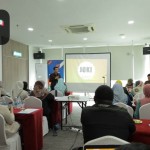Creativity exercises are a great way to discover new ideas and improve overall creativity, so it's important to learn about the different activities you can use to expand your skills. In this article, the author explains what a creativity exercise is, describes the benefits of these exercises and offers a list of 15 you can try individually or with a team.
What is a creativity exercise?
A creativity exercise is an inventive endeavor focused on building creative skills, like problem-solving, communication and innovation, rather than improving a specific creative ability, like painting or dancing. Creativity exercises can be multi-modal, using paper and pen, building materials, found objects or any other items to devise new ideas and expand creative thinking.
These exercises are beneficial for teams to use to improve group cohesion and creativity or for individuals interested in improving their creativity on their own. Practicing idea formulation, connecting unrelated concepts and adapting objects for unique purposes are all useful activities that employees in a variety of industries can use to improve problem-solving and critical-thinking skills.
Benefits of creativity exercises:-
Creativity exercises offer many benefits for individuals, groups or companies who use them, amongst the benefits as stated below:-
- Improved flexible thinking: Creativity exercises improve your mental flexibility. You may see the possibility of small shifts or changes to a project that you didn't notice before.
- Discovery of multi-dimensional ideas: If you or your team have been working in the same field for a long time, you might use the same ideas repeatedly. Creativity exercises help you discover entirely new solutions to repetitive problems.
- Embracing work challenges: With enough practice, work challenges become something to look forward to as an opportunity to show and improve your mental creativity rather than a test delaying your progress.
- Seeing new concepts: Some creativity exercises help develop your creative vision, allowing you to see objects, ideas and problems in a new way. This is highly beneficial when looking for a novel solution to a business challenge.
- Improved teamwork: Creativity exercises help individuals and groups improve teamwork skills like communication, problem-solving and unity.
The 15 Creativity Exercises
1. Incomplete figure test
The incomplete figure test is a drawing exercise. You use a small, simple scribble, like a half-circle or loop, to create a full drawing. To do this in a group, several people use the same scribble to work from, and then they compare the drawings. Seeing how others interpret the same small design can expand your creative thinking and give you new ideas.
2. 30 circles
30 circles is a creativity exercise where the goal is quantity over quality. You're given a sheet of paper with 30 identical circles on it. You have a short amount of time, usually 10 minutes at most, to draw something in as many of the 30 circles as possible. When done as a team, the group members compare the completed circles to see if there are any unifying principles or designs.
3. Paper clip test
The paper clip test is a thinking exercise that is usually done with multiple people at a time. In this activity, groups receive a box of paper clips and find as many uses for them as possible, apart from holding papers. Groups then share their ideas with the rest of their coworkers. This innovation can lead to an increased number of original ideas on work projects.
4. Musical ideas
Sometimes a change of background, like listening intentionally to music, can inspire new ideas. Go to a concert or play music in your office, and write down any ideas or thoughts that come to mind. Assess those ideas to see if you can apply any to your work challenges.
5. Repurposed product
Use the objects on your desk, like staplers, folders, tape, pictures and paper, to create a new product. This activity is also great for groups. After each individual or team has finished repurposing a product, they can compare their creations for uniqueness, ingenuity and practicality. This exercise is especially helpful for developing brainstorming skills.
6. Dictionary story
Select a word at random from the dictionary. Use the word you chose, the word above it and the word below it to create a short story. Finding a way to create an interesting, cohesive story from seemingly random elements can improve your ability to make connections and combine ideas that don't necessarily relate.
7. Compound collaborative
Take a compound word and substitute one word for another. For example, the compound word sunflower could become moonflower. Use your new compound word to create a story or make a drawing. Finding connections between unrelated items can help you improve your critical thinking and process evaluation on the job.
8. Building blocks
Use building blocks to create models of houses, businesses or products. If you do this as a group, see who can make the most intricate, detailed or unique objects. Spatial awareness, which you develop during this activity, can improve your ability to come up with thoughtful designs for work projects of all types.
9. Write poetry
Write a poem about your day in the style of your favorite poet or following the structure of a classic poem, like a sonnet or haiku. Writing with a clear structure in mind forces you to find the ideal word or phrase to fit the constraints, which can improve your overall writing ability.
10. Draw it again
Draw the same object, like a coffee mug, every day for a week or more. See what new details or nuances you notice as you examine the object every day. Extreme focus like this should improve your attention to detail and help you notice new elements in your work.
11. Field trip
Go on a team field trip out of the office. Explore a local garden or walk around downtown to see what new ideas or concepts the group discovers through a change of scenery. Even the act of having a meeting in a new place can spark original ideas.
12. Read
Go to a bookstore or library and explore a section completely unrelated to your job or the books you normally read. Choose a book and read it to see what new knowledge you can glean. Learning about disciplines that are different from your own can introduce you to new ways of managing your work.
13. Freewrite
Schedule a few minutes every morning to write in a stream of consciousness. This type of freewriting, where you write whatever comes to mind consistently without stopping, is a great way to discover some of your subconscious ideas, which could lead to innovative solutions to work challenges.
14. Storyboard
Storyboarding can be a particularly useful creative exercise for establishing new procedures or improving existing processes. Rather than writing out the steps of the procedure, draw each step in a series of small, rectangular boxes, like a comic strip. You might discover a useful new step in the process that you hadn't considered.
15. New out of two
Take two separate products and find a way to combine them. For example, you could use two common office tools, like a stapler and a tape dispenser, to create an interesting new product. Design a marketing strategy and target market for the new product you have created.
In conclusion, the importance of creativity in various aspects of life, whether it's in the workplace, classroom, or workshop. While creativity might initially be associated with artistic fields, the reality is that creative thinking is an essential skill that can benefit individuals and teams across all industries. The utilization of creativity exercises is a powerful tool to cultivate innovative ideas, enhance problem-solving capabilities, and foster a culture of ingenuity.
Creativity exercises, as outlined above, offer a structured approach to expanding one's creative thinking abilities. These exercises are not only valuable for generating novel ideas but also for enhancing teamwork, communication, and adaptability. By engaging in activities like the incomplete figure test, 30 circles, paper clip test, and more, individuals and groups can tap into their creative potential and uncover unconventional solutions to challenges. One of the primary advantages of creativity exercises is their ability to boost mental flexibility. They encourage individuals to explore uncharted territories and consider alternative perspectives, leading to unexpected breakthroughs. Moreover, these exercises encourage the discovery of multi-dimensional ideas, allowing individuals to break away from repetitive patterns and generate fresh approaches to longstanding problems.
Embracing challenges becomes a mindset shift, where obstacles are viewed as opportunities for creative growth. The exercises also foster the development of creative vision, enabling individuals to perceive ordinary objects and problems in innovative ways. This newfound perspective can be instrumental in addressing complex business challenges and driving forward-thinking solutions. Furthermore, teamwork is greatly enhanced through creativity exercises. Collaborative engagement in these activities nurtures effective communication, shared problem-solving, and a sense of unity among team members. The interactive nature of these exercises encourages the exchange of diverse ideas, leading to a synergy that propels innovation. As highlighted by the list of 15 creativity exercises provided in this article, there is a wealth of methods to spark creative thinking. From visual tasks like drawing and building to literary exercises like writing and storytelling, each activity offers a unique pathway to creativity. By stepping outside of comfort zones and embracing activities that challenge conventional thinking, individuals can unlock hidden potential and strengthen their creative muscles.
Last but not least, creativity exercises are not merely tools for artistic expression. They are essential instruments for fostering imagination, originality, and problem-solving skills. Embracing these exercises, whether independently or within a group, can lead to a transformational shift in how challenges are approached and how solutions are generated. In a world that thrives on innovation, integrating creativity exercises into various facets of life is a strategic investment in personal and collective growth.










